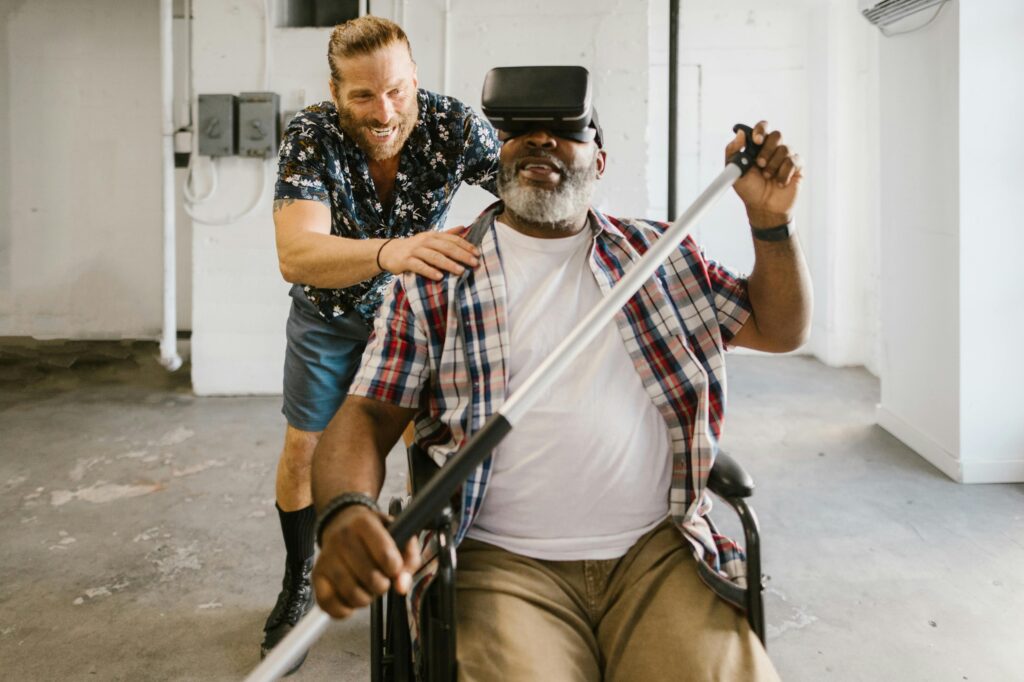For decades, video games were primarily seen as a form of entertainment, often criticized for promoting sedentary behavior or excessive screen time. However, recent advancements in medical research and technology have revealed a surprising and powerful application for gaming: therapy and rehabilitation.
Healthcare professionals now recognize that video games—when used intentionally—can enhance physical recovery, improve cognitive function, and support mental health treatment. From stroke rehabilitation to PTSD therapy, gaming has transitioned from a leisure activity to a legitimate therapeutic tool.

This article explores the science behind gaming in rehabilitation, its real-world applications, and the evidence supporting its effectiveness. We will examine how different types of games assist in recovery, the challenges of integrating gaming into medical treatment, and what the future holds for this innovative approach.
How Gaming Assists Physical Rehabilitation
1. Motor Skill Recovery After Neurological Damage
Patients recovering from strokes, traumatic brain injuries (TBI), or spinal cord damage often struggle with motor control. Traditional physical therapy involves repetitive exercises, which can be tedious and demotivating. Gaming introduces an engaging alternative by turning rehabilitation into an interactive experience.
- Motion-Based Gaming (Wii, Kinect, VR)
- Games like Wii Sports and Beat Saber require precise arm movements, helping stroke patients rebuild coordination.
- Studies from the American Journal of Physical Medicine & Rehabilitation show that patients using motion-controlled games regain arm mobility 30% faster than those relying solely on conventional therapy.
- VR rehabilitation systems (such as MindMotion GO) allow patients to practice real-world movements in a virtual space, increasing motivation and adherence to therapy.
- Fine Motor Skill Development
- Patients with conditions like cerebral palsy or multiple sclerosis often struggle with fine motor skills.
- Games that require precise finger movements (e.g., Guitar Hero, Just Dance) help improve dexterity.
- Occupational therapists at Shriners Hospitals for Children have reported significant improvements in hand-eye coordination among pediatric patients using gaming-based exercises.
2. Balance and Mobility Training
Balance disorders are common in conditions like Parkinson’s disease, vestibular dysfunction, and post-surgical recovery. Traditional balance exercises can be repetitive and frustrating, leading to poor compliance.
- Virtual Reality (VR) Balance Games
- VR systems like VR Balance Boards and Oculus Quest balance games provide real-time feedback, helping patients adjust posture and gait.
- A Mayo Clinic study found that Parkinson’s patients using VR balance training showed 40% better stability after 12 weeks compared to standard therapy.
- Stroke survivors using VR-based walking simulations (e.g., GaitAid) experienced improved stride length and walking speed.
- Exergaming (Exercise + Gaming)
- Devices like the Nintendo Switch Ring Fit Adventure combine cardio and strength training with gameplay.
- Elderly patients in assisted living facilities have shown improved mobility and reduced fall risk after consistent exergaming sessions.
3. Pain Management Through Distraction and Immersion
Chronic pain patients, including burn victims and post-surgical patients, often require distraction techniques to cope with discomfort.
- VR Distraction Therapy
- The University of Washington’s Harborview Burn Center uses VR games during wound dressing changes.
- Patients report up to 50% less pain when immersed in a virtual environment (Journal of Pain Research).
- SnowWorld, a VR game designed for burn victims, has been particularly effective in reducing pain perception.
- Biofeedback Games
- Games like Wild Divine use heart rate and stress sensors to teach relaxation techniques.
- Chronic pain patients learn to control physiological responses, reducing reliance on medication.
Gaming in Cognitive and Mental Health Therapy
1. Memory and Attention Improvement
Cognitive impairments from Alzheimer’s, ADHD, or traumatic brain injuries (TBI) can be addressed through targeted gaming interventions.
- Brain-Training Games
- Lumosity, CogniFit, and Peak offer scientifically designed exercises to enhance memory, focus, and problem-solving.
- A Harvard Medical School study found that TBI patients who engaged in cognitive gaming for 12 weeks showed 40% better attention spans.
- Elderly participants using brain-training games delayed cognitive decline by 2-3 years (Frontiers in Aging Neuroscience).
- Serious Games for Executive Function
- Minecraft has been used in therapy to improve planning and organizational skills in children with ADHD.
- Therapists at Child Mind Institute report improved task persistence in young patients after structured gameplay sessions.
2. Anxiety, Depression, and PTSD Relief
Mental health professionals are increasingly incorporating gaming into psychotherapy.
- Calming and Mindfulness Games
- Animal Crossing and Journey provide relaxing, low-stress environments that reduce anxiety.
- A University of California study found that 20 minutes of therapeutic gaming lowered cortisol (stress hormone) levels by 15%.
- Exposure Therapy for PTSD
- Veterans with PTSD undergo VR-based exposure therapy using games like Bravemind.
- The U.S. Department of Veterans Affairs reports 60% symptom reduction in patients who complete VR therapy.
3. Social Skills Development for Autism and Social Anxiety
Individuals with autism spectrum disorder (ASD) or social anxiety often struggle with communication. Gaming provides a structured way to practice interaction.
- Multiplayer Cooperative Games
- Minecraft group sessions help children with ASD practice teamwork and verbal communication.
- Roblox social games allow safe, moderated interaction for socially anxious teens.
- VR Social Simulations
- Programs like Floreo teach facial recognition and conversation skills in a controlled virtual setting.
Real-World Applications in Healthcare
1. Hospital-Based Gaming Therapy Programs
- Shepherd Center (Atlanta, GA) – Uses VR-assisted gait training for spinal injury patients.
- St. Jude Children’s Research Hospital – Implements gaming to distract pediatric patients during chemotherapy.
- Walter Reed National Military Medical Center – Treats amputees with VR-based phantom limb pain therapy.
2. Home-Based Rehabilitation Solutions
- Rey Interactive – A motion-tracking system that guides stroke patients through at-home exercises.
- Neuro Rehab VR – A subscription-based VR platform for remote cognitive therapy.
3. Military and Veteran Programs
- VA’s VR PTSD Therapy – Uses Bravemind to simulate combat scenarios in a controlled setting.
- Warfighter Engaged – Provides adaptive gaming controllers for injured veterans.
Scientific Evidence Supporting Gaming Therapy
- Stroke Recovery – NIH study shows 70% improvement in hand mobility with VR rehab.
- Parkinson’s Disease – Mayo Clinic reports better balance and motor control.
- ADHD & Autism – Journal of Autism and Developmental Disorders confirms enhanced social engagement.
Challenges and Limitations
- Cost Barriers – High-end VR systems remain expensive for some clinics.
- Technology Literacy – Elderly patients may struggle with gaming interfaces.
- Overuse Risks – Requires professional supervision to prevent addiction.
FAQ
1. Can gaming fully replace traditional therapy?
No, but it enhances engagement and speeds up recovery when combined with conventional methods.
2. What types of games are best for therapy?
- Physical rehab: Beat Saber, Wii Fit, VR balance games
- Cognitive training: Lumosity, CogniFit
- Mental health: Animal Crossing, Journey, Bravemind
3. Are there risks to gaming therapy?
Excessive unsupervised play could lead to dependency, but structured sessions minimize risks.
Conclusion
Gaming has evolved into a scientifically validated tool for therapy and rehabilitation. From helping stroke survivors regain movement to assisting veterans with PTSD, its applications are vast and growing. While challenges like cost and accessibility remain, the future of gaming in healthcare is promising.
For patients, caregivers, and medical professionals, integrating gaming into treatment plans offers a dynamic, engaging, and effective approach to recovery. As research continues, we can expect even more innovative uses of gaming in medicine.


